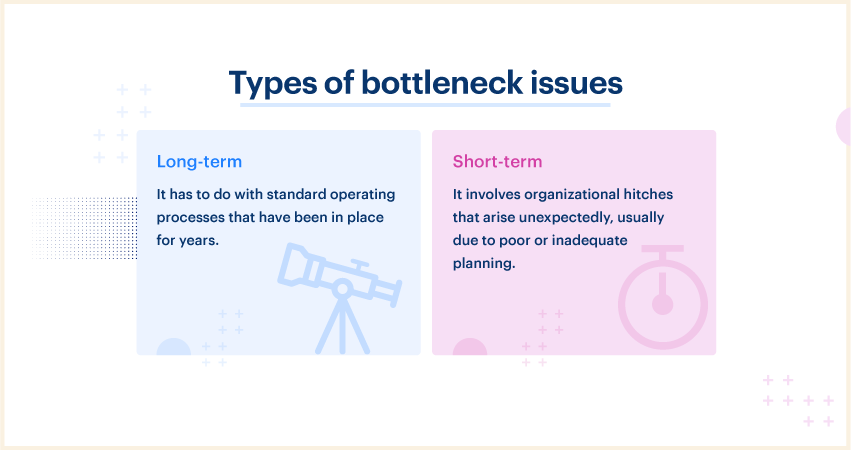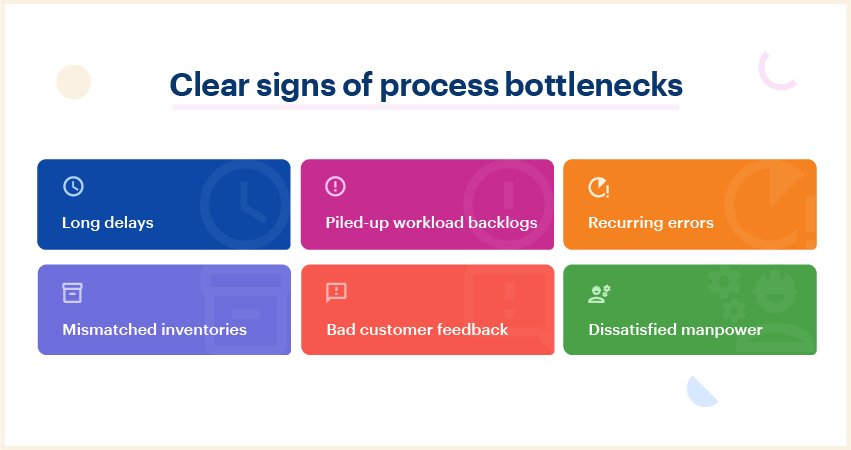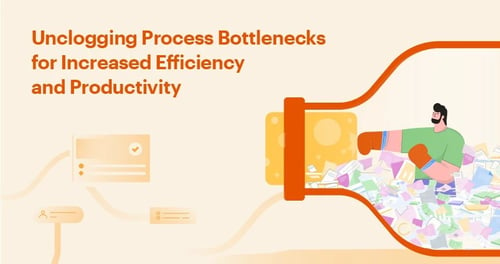Workflows can be considerably hampered when you hit a bottleneck. Efficiency and productivity, no doubt, will be significantly affected. Business owners and managers have to identify bottlenecks and find solutions for timely fixes to avoid losses in time, money, and resources.
If you’re hustling and bustling at the workplace, it must mean that your business is thriving, right? While it might seem like a good problem to be busy as a bee, you could find yourself in quite a hitch if increased workloads are not managed efficiently.
Business processes have to be rationalized and streamlined to avoid putting unreasonable added loads on the workflow. Complex and complicated workflows will lead you to bottlenecks. Workforce productivity could suffer if you do not have a system for reducing bottlenecks in place. This would affect your overall profitability as well.
Defining a Bottleneck in Business Process Workflows
A bottleneck in business is defined as a congested situation where the number of requests exceeds the processing capacity. Workforce, software/hardware systems, processes, etc., can cause a process bottleneck.
There will be a slowdown in your workflow and you could incur unnecessary operational costs. You can certainly manage bottleneck situations and remain in control of your workflow processes. You then prevent timeline delays and interruptions as well as budget spikes.
It would be beneficial for business owners and managers like you to learn how to identify bottlenecks and conduct a bottleneck analysis. Such an exercise would allow you to formulate and put in place the necessary measures for navigating bottlenecks or even avoiding them altogether. One thing that you have to know, however, is that the only way to identify these hitches is to observe your current workflows. This means that you have to spot them as they are already affecting your workflow. This also makes it more imperative for you to be able to identify them right away and apply the right solutions.
Bottlenecks in your workflows could involve manpower, software/hardware systems, processes, and everything else that causes a slowdown or congestion.
Types of Bottleneck

There are two types of bottleneck issues: long-term and short-term.
Long-term
It has to do with standard operating processes that have been in place for years.
Short-term
It involves organizational hitches that arise unexpectedly, usually due to poor or inadequate planning. Inadequate resources (infrastructure), outdated and irrelevant process compliance requirements (regulatory), and limited capabilities (operational) could also cause short-term bottlenecks.
One Step at a Time
It takes diligence and attention to detail to identify bottlenecks. You would need a visualization tool (i.e. time trackers, fishbone diagrams, flow charts, etc.) to track and monitor your business processes in each step or task. This must be done on an individual and departmental level depending on the manpower involved and the scope of the project or process. Tasks and activities will have to be mapped out, taking note of the time it takes to complete them. Queuing time is mapped out as well as this is clearly an indication of a bottleneck — if there’s a considerable amount of idle time before a task is actually handled, there’s definitely a bottleneck.
Likewise, if it takes a long time for a task to be completed, there could be a bottleneck in how it’s handled. It could be the process itself, the skill level or training of the manpower, the capabilities of the equipment, etc. All these details should be part of the visual identification and mapping exercise. In some cases, companies hire business analysts and process management consultants to guide them through this exercise. Some opt for online tools and automated software to identify and unclog their bottlenecks.
Pay Attention to Bottlenecks
You cannot ignore or simply brush aside a bottleneck in a process. Doing so would not be good for your productivity and profitability. There’s also the effect on your work force’s physical and mental health to take into consideration. Not paying attention to bottlenecks could result in a snowball of dire effects on the overall state and performance of your business.

Here are some clear signs of process bottlenecks:
- Long delays
- Piled-up workload backlogs
- Recurring errors
- Mismatched inventories
- Bad customer feedback
- Dissatisfied manpower
Consider one or a combination of these signs as a red flag. Once you spot them, dig deeper and get down to the root of the matter so you can quickly unclog your bottlenecks. There are tools and frameworks to help boost your capability in getting rid of these clogs in your processes. The Kissflow Workflow method is one effective fix for most bottleneck example situations.
Learn More: Business Process Management
Kiss Bottlenecks Goodbye With Kissflow Process
You can unclog your bottlenecks and increase efficiency and productivity with an end-to-end workflow management platform from Kissflow. This is the only platform available globally that allows you to build structured and unstructured workflows that fit your needs. With a user-friendly interface, you can build your workflows with drag-and-drop ease. You can also easily integrate this platform with other third-party business solutions to better streamline your processes. Valuable insight from reports and analytics is served upright in front of you so you know where you are in your process’s improvement efforts. This allows you to determine your plan of action quickly and get rid of your bottlenecks even before they start to adversely impact your critical operations.
You might not be aware of them — or perhaps you are but would rather not rock the boat. You do not have to deal with bottleneck issues and just absorb the costs. Technology and automation are definitely a must in any business these days. With Kissflow Process you can make sure that you are not taking any losses and are maximizing your profit potential.















